Sansevieria pinguicula, also known as Dracaena pinguicula, is a beautiful succulent native to the Bura area of Kenya. This unique plant has also earned the nickname Walking Sansevieria due to the way in which it produces new offsets.
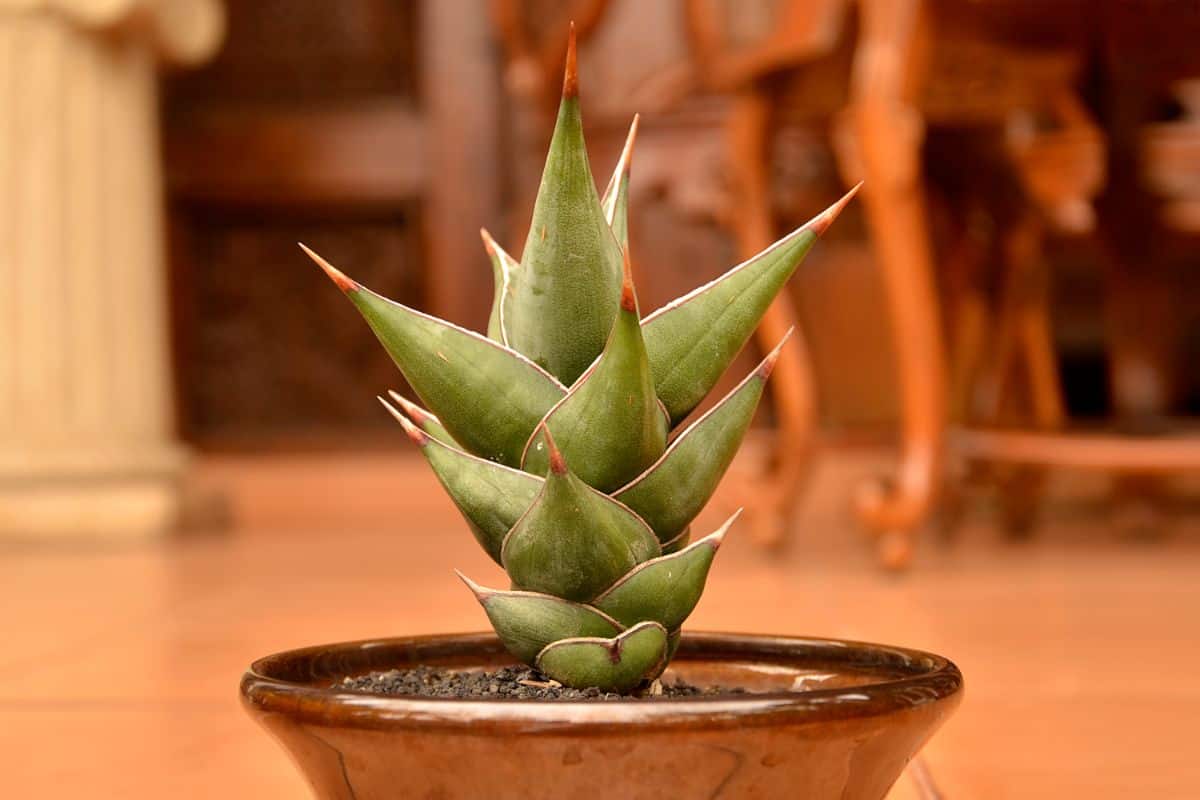
Rather than producing offsets via underground rhizomes, this succulent species produces offsets from its aerial stolons. The offsets then develop roots that extend to the soil in an almost stilt-like appearance, leading to the image of the baby plant walking away from the parent plant.
The plant’s scientific name also refers to the plant’s appearance. It is derived from the Latin word pinguis, which means “fat”, and is a description of the plant’s leaves.
It’s important to note that Sansevieria are toxic if consumed, so use caution when growing this plant in households with pets and small children. The leaves contain a toxin that can cause nausea, vomiting, and diarrhea. Though rarely fatal, serious illness is possible.
Jump to:
Sansevieria pinguicula Appearance
| Name: | Sansevieria pinguicula |
| Soil: | Well-draining soil |
| Blooming: | Rare but mostly in winter |
| Light: | 12 to 16 hours of indirect light |
| Water: | Fully dry out before watering |
| Propagation: | Leaf cuttings, offsets, and seeds. |
The Walking Sansevieria is a short plant that is frequently confused with Agave. The leaves are arranged in a rosette shape and the plant can reach up to 12 inches in diameter at maturity. The leaves also measure just over an inch in thickness.
S. pinguicula is typically a bluish green color with a waxy cuticle. The leaf margins are reddish-brown leading to a sharp spine at the tip of the leaf. When fully hydrated, the leaves are smooth and plump, but will develop deep grooves when the plant is in need of water.
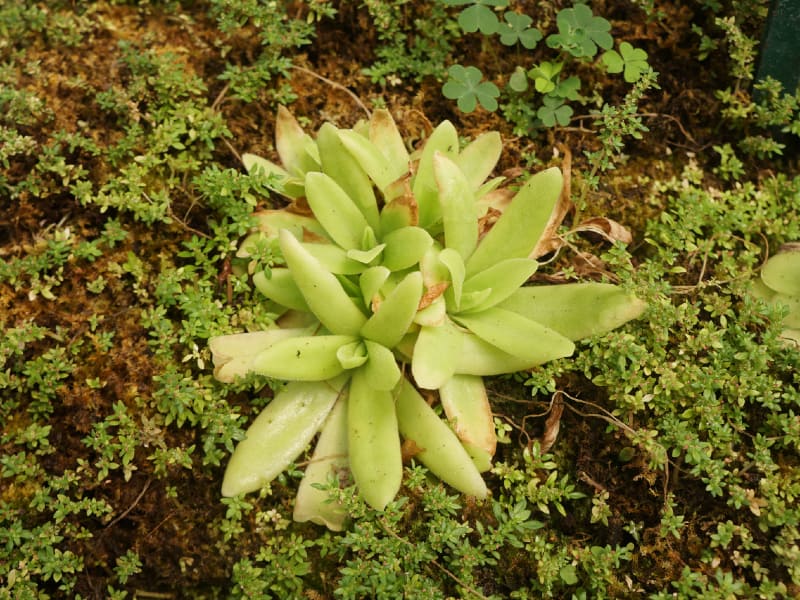
Buy it from:
As previously stated, Sansevieria pinguicula are known for their unique stilt-shaped roots which often lift the plant above the surface of the soil. The roots are brown in color and support the plant while fine roots absorb nutrients and moisture below the soil surface.
In times of drought, the fine roots will frequently die and regrow when the rainy season arrives. The thick, supportive roots will stay alive, however, even while the plant itself is dormant.
Though this plant rarely blooms, it can produce clusters of white, bottle-shaped flowers atop a long stalk produced at the center of the rosette. One of the most unique features of this plant is that it will stop growing after it blooms. However, this should not be confused with Agave, which die after blooming.
Cultivars
Though D. pinguicula is not a plant that’s commonly found in succulent collections, there are a few different cultivars. They can be somewhat difficult to find, but for the determined collector, anything is possible.
The main difference between the varieties is the shape and color of the leaves. Each of the cultivars listed here also have a variegated form, though the variegated forms tend to be more expensive and difficult to find.
No products found.
Sansevieria pinguicula ‘Unicorn’
The Unicorn variety can be distinguished by the arrangement of its leaves. Rather than the typical rosette-shaped arrangement, the leaves of Unicorn tend to grow in more of a fan shape. However, they will begin to twist more as the plant ages.
Sansevieria pinguicula ‘Dagger’
As the name suggests, the leaves of the Dagger variety tend to be a bit wider and shorter than the original variety. They tend to closely resemble the shape of a dagger. The leaves of Dagger grow in the traditional rosette pattern.
Sansevieria pinguicula ‘Long Leaf’
Again, the descriptive name ‘Long Leaf’ gives away this variety’s distinguishing characteristic. The leaves of this cultivar tend to be quite a bit longer than other varieties of S. pinguicula.
Caring for Sansevieria pinguicula
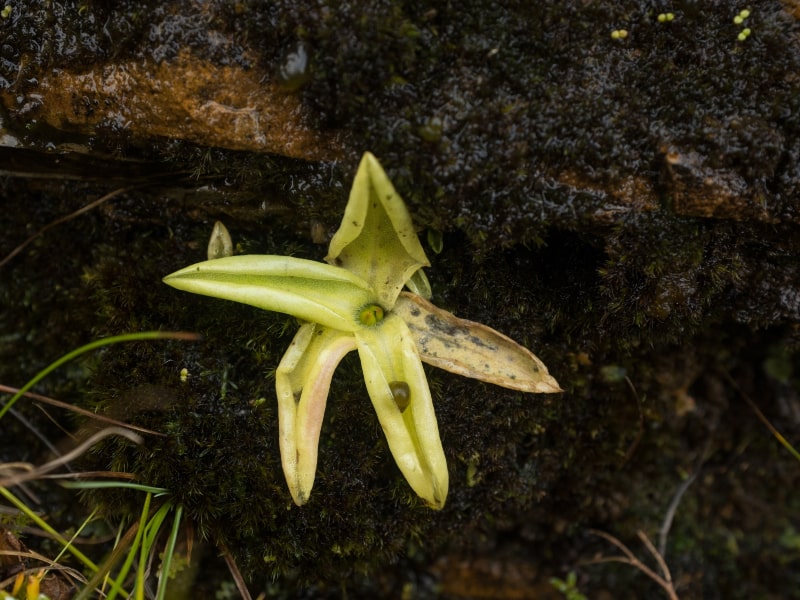
Walking Sansevieria are known for being hardy plants, similar to other species of Sansevieria. They do not tolerate a hands-on approach to their care and instead prefer to be more neglected. As with most succulents, overwatering is the most frequent cause of problems.
As long as this plant’s basic care requirements are met, it’s not too picky in terms of environment. These succulents are low-maintenance plants that can thrive in a variety of indoor spaces, as well as outdoors if the climate is warm enough year-round.
This is a particularly slow-growing species of Sansevieria, so do not expect significant growth in a short period of time.
Light
As with most Sansevieria, S. pinguicula is fairly adaptable to surviving in a wide range of light conditions. Though they can grow in low light environments, they will not thrive and may become etiolated over time. Darker coloring is also a sign of inadequate lighting with these succulents.
Ideally, Walking Sansevieria need bright light when grown indoors. Between 12 and 16 hours of bright, indirect light is best. In order to provide your Sansevieria with enough light, you may need to supplement natural light with a full-spectrum grow light.
Grow lights are a great way to provide any indoor plant with additional light. They come in a wide range of shapes, sizes, and prices to suit any indoor space. Sansevieria kept in low light environments can grow well when placed under a grow light.
If your climate stays warm enough year-round, you may also consider growing your Sansevieria outdoors. These plants can tolerate direct sunlight, but partial shade is best. The heat of the afternoon sun can be too much for many Sansevieria, so it’s best to keep them shaded during this time.
During the winter, when days are shorter, dormancy can be induced by decreasing or stopping watering. This simulates the plant’s natural seasonal changes, but it’s not necessary for a plant kept indoors year-round.
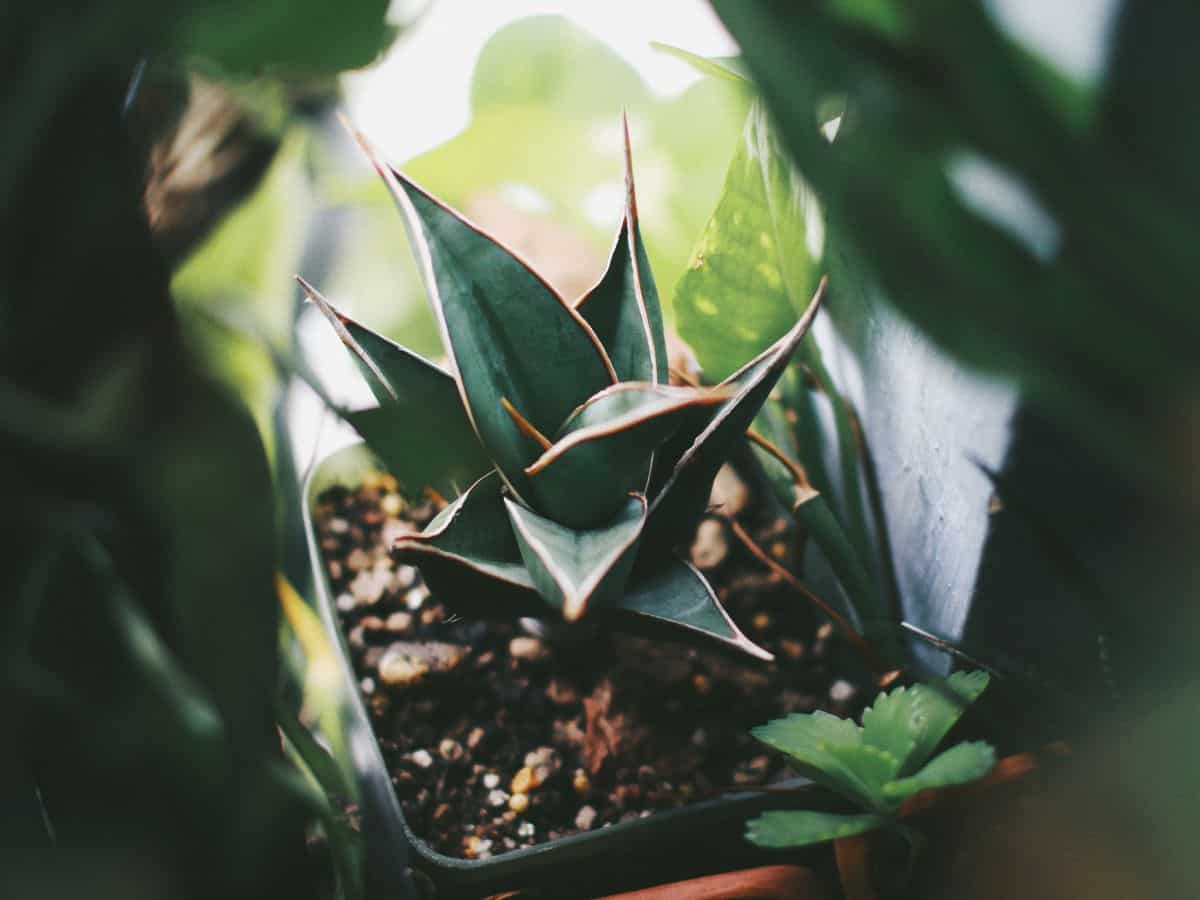
Water
S. pinguicula is no different from any other species of succulent in terms of watering preferences. They enjoy being watered deeply, but infrequently. Ideally, they should be given enough water to thoroughly soak the soil, but then be allowed to fully dry out before watering again.
Overwatering is the leading cause of problems with Sansevieria, so it’s important to check the soil before you water each and every time. This can be accomplished by either inserting your finger or a soil moisture meter into the soil near the roots.
If the soil is moist, it’s best to wait a few days and check the soil again. If the soil is dry, you can proceed with watering. This practice is recommended over watering on a strict schedule and will help prevent accidental overwatering.
Watering on a schedule is considered less ideal as it doesn’t account for the changes in season or weather. During humid or wet weather, the soil will not dry out as quickly and the plant will need watered less frequently. Hot, dry weather will require more frequent watering.
This plant is drought tolerant, so if in doubt, it’s best to allow the plant to become too dry rather than overwater. A dry plant can be recognized by the deep grooves that develop on the undersides of the leaves.
An overwatered Sansevieria will develop soft, limp, yellow leaves. The leaves near the bottom of the plant will be the first to go. If these signs are ignored, root rot will likely develop. Unfortunately, once root rot sets in, there’s little that can be done to save the plant.
Temperature
Walking Sansevieria are not frost tolerant plants, so you’ll need to be careful about exposing your plant to cold temperatures. These succulents can be sensitive and if temperatures drop below about 40 degrees Fahrenheit, the plant may suffer. This is especially true if the soil is wet.
If the soil is dry, S. pinguicula can survive temperatures closer to freezing, but if you’re expecting temperatures to drop much lower than that, you’ll need to plan on bringing your plant indoors.
Extreme heat usually isn’t a problem for this plant, especially if it’s kept shaded during the hottest part of the day. During heat waves, it may need to be watered more frequently, but if well hydrated kept protected from direct afternoon sunlight it should survive without a problem.
For Sansevieria grown indoors, extreme temperatures are a rarely a concern. However, you should keep your plant protected from areas such as doorways or windows that may experience sudden changes in temperature or drafts.
Soil
Sansevieria pinguicula prefer well-draining soil. A coarse soil mix containing ingredients such as coarse sand, decomposed granite, gravel, perlite, or vermiculite is ideal. Soils containing large amounts of clay, peat moss, or coconut coir will retain too much moisture.
It’s important to use the correct type of soil to encourage better drainage as well as air flow to the roots. Though some of the roots of S. pinguicula are above the soil’s surface, the finer roots below still need some air flow.
If you’re a DIY type of gardener, you can make your own soil mix by combining these ingredients along with a small amount of organic matter to create your perfect substrate.
However, most gardeners would prefer to buy a commercial soil mix. Commercial soils made for cacti and succulents are ideal for Sansevieria, but you can always add different materials to adjust the soil to your liking.
Whatever you do, avoid lining the bottom of your container with rocks. Though this is a commonly recommended practice to increase drainage, it actually does the opposite. Instead of encouraging better drainage, it creates a “perched water table”, which raises the water closer to your plants’ roots and puts your plant at risk of developing root rot.
Read Related Topic: Copiapoa Cinerea
Container
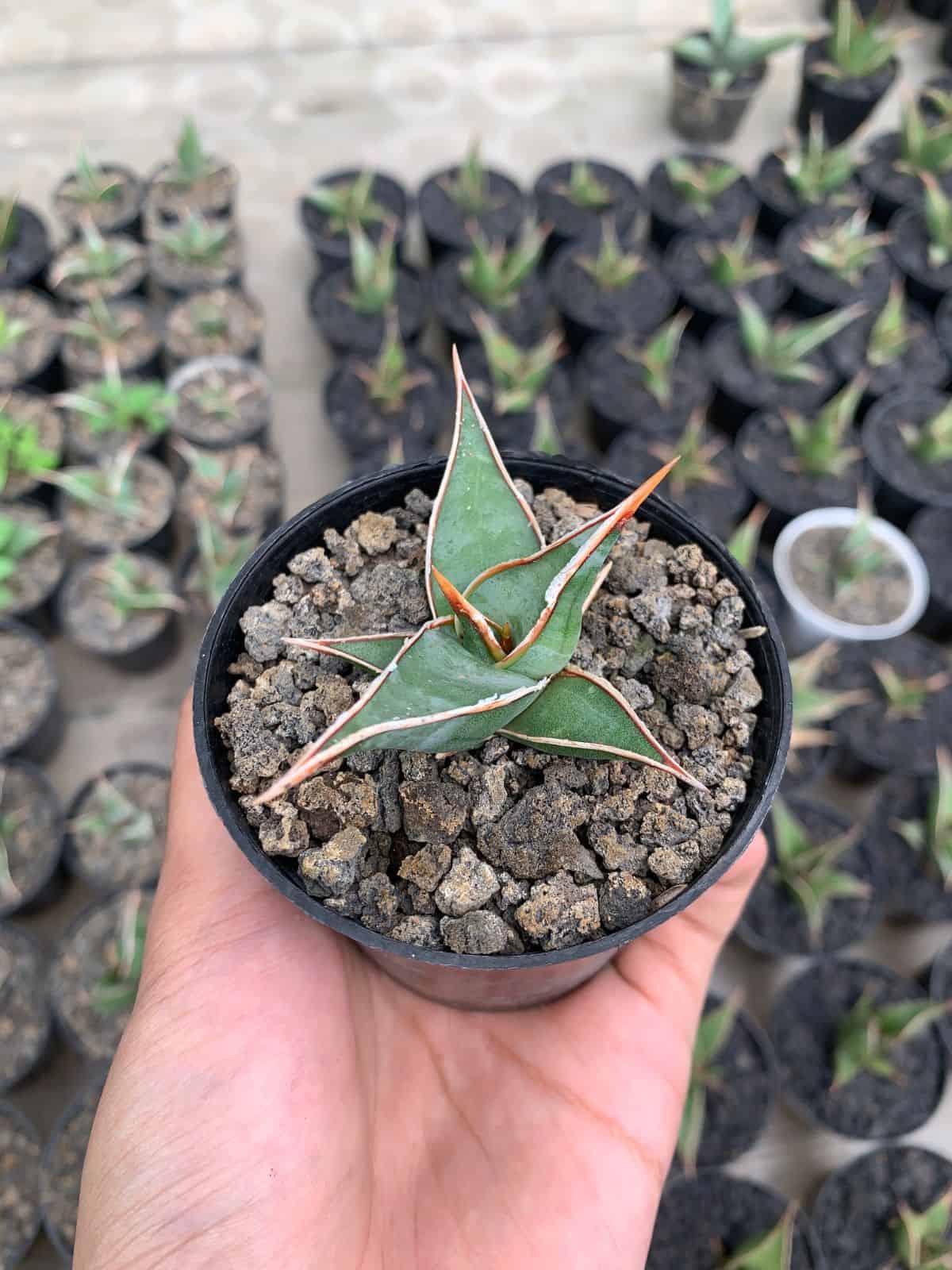
Choosing the correct container for your Sansevieria is an important decision that can have a bigger impact on your plant’s care than you might think. As you may be able to guess, the most important feature of a good succulent container is drainage.
Though there are plenty of cute pots to be found that lack drainage holes, it’s not recommended to use these planters for succulents. Drainage is key in preventing overwatering and without holes, you’ll need to be incredibly precise with your watering schedule.
Since most gardeners have yet to find the perfect watering schedule, it’s best to choose a container with holes to allow the excess moisture to drain away, rather than sit at the bottom of the pot.
If you’re prone to overwatering, you may also want to consider using a terra cotta pot. Terra cotta can absorb moisture from the soil, which can help dry your plant out faster if you accidentally give it water before it’s ready.
However, this can also dry out your plant more quickly than you’d like in hot, dry weather. If you’d prefer a pot without moisture-absorbing abilities, consider a plastic or glazed ceramic pot.
Propagating Sansevieria pinguicula
Though Walking Sansevieria are not difficult plants to propagate, they are incredibly slow-growing. This can make traditional propagation methods, such as growing from seeds, a bit more difficult than usual.
There are three methods of Sansevieria propagation, but most gardeners will find that two of the three methods will have a higher rate of success.
It’s also worth noting that offsets are the preferred propagation method for variegated Sansevieria. Leaf cuttings don’t always preserve the variegation, so if more variegated specimens are desired, it’s best to separate offsets rather than taking cuttings.
Offsets
Separating offsets from the parent Sansevieria pinguicula is by far the easiest method of propagation. The reason this is the most recommended method is that the plant does most of the work by producing tiny plantlets with established stilt-like roots, so all you have to do is carefully separate it.
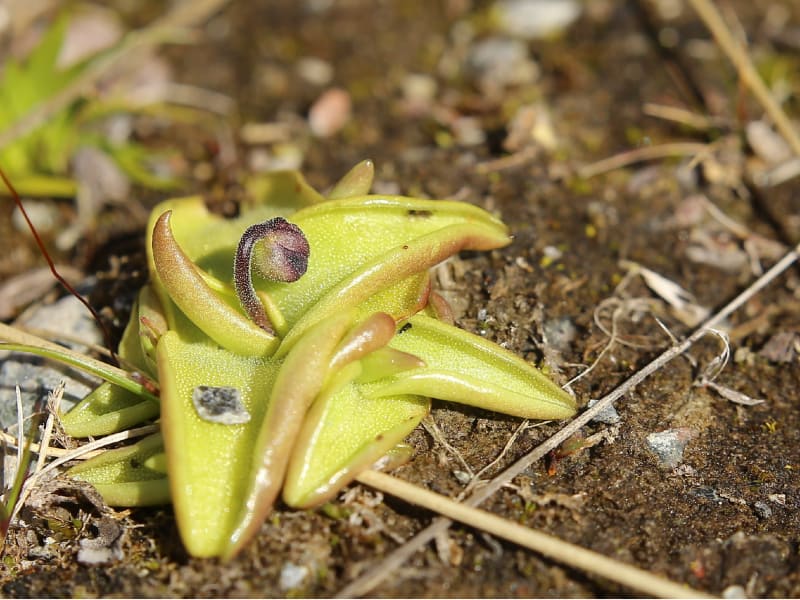
To increase your chances of success, remove only plantlets that have roots that are at least an inch in length. Offsets with longer root systems will be able to establish themselves easier than those with barely any root growth.
When removing offsets, be sure to use sharp, clean scissors or shears. Sharp tools are more likely to make clean cuts and limit any damage to your plants.
After you’ve snipped the offsets away from the parent plant, you’ll need to allow them to air dry for a few days. This allows the cuts to callous and limits the risk of infection by fungus or bacteria.
Once the wounds have calloused, the plantlets can safely be planted in their own container of well-draining soil. These plantlets can then be cared for just as you would a mature S. pinguicula.
It should be noted that it can take many months, or even up to a year, for this species to start producing fine roots below the soil’s surface. If you notice little to no growth in the first few months, there’s no need to be concerned.
Cuttings
Like other species of Sansevieria, Walking Pinguicula can also be propagated using leaf cuttings. It’s recommended to take leaf cuttings after the plant has bloomed and is no longer actively growing.
Similar to removing offsets, cuttings should be taken using only clean, sharp scissors or shears to ensure that clean cuts are made. Most gardeners suggest taking a whole leaf rather than a section if possible.
Leaf cuttings will also need to be set aside, out of direct sunlight, for a few days to allow the cuttings’ wounds to dry and callous. Once the cuts have calloused, the cutting is ready for planting.
As an optional step, you may also dip your cutting into a rooting aid such as rooting hormone powder to encourage faster rooting, but this isn’t required for healthy propagation. A cutting can root just fine without this extra step, but it may take a bit longer.
When you’re ready for planting, place the cutting into moist, well-draining soil. With time, the leaf will begin producing roots and a stolon from which a new plant will grow.
Again, this will not be a fast process, so it’s important to be patient while waiting for your Sansevieria to root.
You May Also Like: Agave Isthmensis
Seeds
Growing Sansevieria pinguicula from seeds is generally not a recommended method of propagation. This species grows so slowly and rarely blooms so collecting seeds is not a particularly reliable method of creating new plants.
However, if you’re determined to try growing Walking Sansevieria from seeds, you can either collect them from your existing plant or try to find a seed vendor that carries them. This plant can be difficult to find as it is, so seeds will be particularly challenging to locate.
If you are able to get your hands on seeds, you can sow them in a shallow container of well-draining soil. The seeds can be sprinkled across the soil’s surface but should not be buried.
The soil will need to be kept moist during germination, so it’s recommended to cover the container with a seed tray lid, plastic wrap, or glass sheet.
After a few weeks, tiny seedlings may begin appearing at the soil’s surface. Once the seedlings have sprouted, you can remove the cover to ensure that the seedlings and unsprouted seeds do not rot.
At this point, the soil can be allowed to dry out a bit and the plants can be treated more like mature specimens.
However, it’s important to mention that it will be some time until the seedlings are large enough to be transplanted to their own containers. S. pinguicula is an incredibly slow-growing plant, so it could be many months before your seedlings are sturdy enough to be moved safely.


